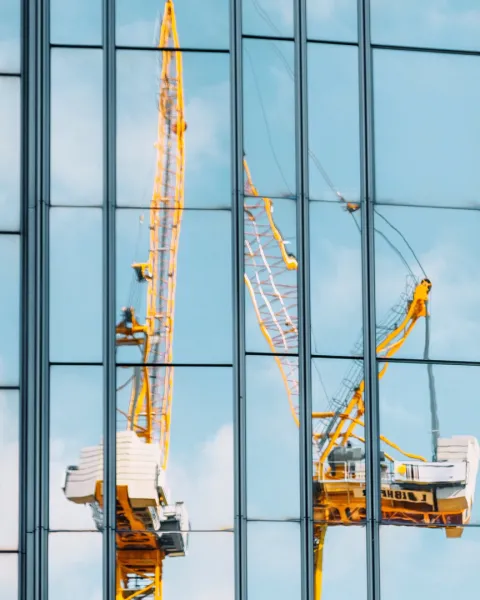The largest construction show in New York, the 2024 New York Build Expo, attracted architects, designers, contractors, and construction professionals from across the tri-state area. The event explored trends in the industry, including the prevalence of rapidly developing AI, ensuring building accessibility for individuals with a disability, mental health concerns for employers to actively address, and fostering diversity amongst the industry group.
AI Technology
A major theme across many of the more than 400 exhibitors was how best to use artificial intelligence (AI) and machine learning (ML) to overcome challenges in the construction industry. Construction executives appear to be embracing both AI and ML technologies to enhance efficiency and drive innovation. From overcoming challenges such as cost overruns and design clashes, AI is proving to be essential to construction. One vendor, for example, showcased a BIM (building innovation modeling) model that used virtual reality to create a 3D model of the project. Another vendor, a software company, utilizes AI algorithms to estimate cost and timelines. In his presentation, “Rise of Machines: What does AI Mean for Construction,” founder and CEO of Poliark, Eda Erol, addressed ways AI can foster a more sustainable future for the architecture and construction industries.
Accessibility
One presentation, titled “Accessible Design and Inclusive City Centers: Understanding the Public Right of Way Rule,” discussed the emerging rules and regulations for ensuring that individuals with a disability have access to all properties.
The presentation discussed the significance of accessibility, its impact, and the supporting statistics. The presentation also dove into the regulations that exist to ensure that individuals with disabilities have equal opportunities, rights, and protections across all aspects of life, including employment, education, public accommodations, transportation, and more. Regulations discussed included the Americans With Disability Act (ADA), the Rehabilitation Act of 1973, and the Fair Housing Act. The presentation shared a four-prong approach to ensuring a true sense of inclusion for individuals with a disability: (1) physical environment; (2) digital environment; (3) social environment); and (4) sensory environment.
The presentation closed with a detailed discussion of the difference between “compliance” versus “inclusion.” Compliance, the group discussed, refers to adhering to laws, standards, or regulations. In the context of disability rights, compliance often involves meeting legal requirements, such as providing accessible facilities as mandated by the ADA. On the other hand, the group shared, inclusion goes beyond mere compliance. Inclusion creates an environment where people of all abilities are fully integrated and have equal opportunities, services, and resources. Inclusion focuses on embracing diversity and ensuring that individuals with disabilities are not only accommodated, but actively and meaningfully involved in all aspects of society.
Mental Health
The “Mental Health and Suicide Prevention in Construction” presentation shared that the construction industry suicide rate is at nearly 50 deaths per 100,000 employees. Male construction workers experience a suicide rate 65 percent higher than all U.S. male workers.
The presentation gave employers an overview of how to facilitate a caring culture and to be a “best-in-class employer” to provide suicide prevention to workers. To do this, employers should start by developing a zero-tolerance or anti-harassment policy for all workers. Employers should encourage workers to share stories of overcoming these struggles. Additionally, to avoid a feeling of separation or isolation amongst workers, employers should create a support structure for similarly situated employees. This can include the development of employee resource groups designed to encourage employees to speak out, feel supported, and share concerns in a safe space. The presenters also discussed the importance of setting reasonable expectations for construction staff, including celebrating the wins, large and small, and learning from any losses.
Diversity
Focused on creating opportunities and overcoming challenges for women in the workplace, a panel discussed issues women face in the construction industry. Topics included earning respect; voice amplification or ensuring that women have their voices heard; gender stereotypes; and safety concerns or ensuring that women are given the appropriate personal protective equipment (PPE) for their bodies. The Occupational Safety and Health Administration (OSHA) has recognized many of these issues in construction. For example, OSHA has proposed changes to the PPE standard, noting that PPE must fit each worker to protect them from occupational hazards.
No doubt the topics showcased at the 2024 New York Build Expo will continue to shape the construction industry.
Please contact a Jackson Lewis attorney with any questions.
© Jackson Lewis P.C. This material is provided for informational purposes only. It is not intended to constitute legal advice nor does it create a client-lawyer relationship between Jackson Lewis and any recipient. Recipients should consult with counsel before taking any actions based on the information contained within this material. This material may be considered attorney advertising in some jurisdictions. Prior results do not guarantee a similar outcome.
Focused on employment and labor law since 1958, Jackson Lewis P.C.’s 1,100+ attorneys located in major cities nationwide consistently identify and respond to new ways workplace law intersects business. We help employers develop proactive strategies, strong policies and business-oriented solutions to cultivate high-functioning workforces that are engaged and stable, and share our clients’ goals to emphasize belonging and respect for the contributions of every employee. For more information, visit https://www.jacksonlewis.com.


